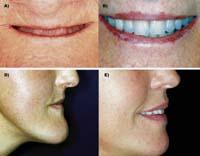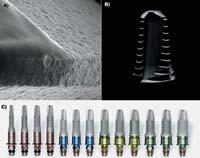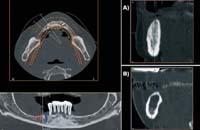Scientific development of dental implants
Farmazian doktorea. Biofarmazia, Farmakozinetika eta Farmazia-teknologiako irakasle kolaboratzailea
Farmazia Fakultatea UPV-EHU, Vitoria-Gasteiz

In addition, being not well seen in the current society, the lack of teeth can cause negative psychological effects, being able to cause psychological alterations, depression or traumas. In these situations, talking, eating, or smiling can only cause shame and there is a risk of creating complexes that can last a lifetime.
To deal with these situations, the first decision is to go to the dentist to place one or more new dental implants. Dental implants will be accompanied by prostheses (artificial teeth) that recover their functionality and initial aesthetics. However, what readers may not know is that the functionality of all dental implants, the protocols of implantation and, in short, the long-term efficiency are not at all equal or similar. Sometimes implantation of implants causes infections, pain, disease, and inflammation. On other occasions, the inadequacy of the implantation protocols of the implants significantly limits the life of the implants and their functioning over time, with the consequent risk of loss of the implants.
Strict protocols

With the aim of improving protocols and techniques, the Biotechnology Institute (BTI) of Vitoria-Gasteiz has carried out over the past 15 years an intense research and effort that has revolutionized the world of dental implants. In its breast, techniques, dental implants and protocols have been developed that have become pointers. And the Autonomous Community of the Basque Country has gained fame among dentists from all over the world.
The scientific development of dental implants is an ambitious goal and such an ambitious goal requires expert professionals in different scientific fields. Among others, experienced dentists and implantologists, who maintain a daily relationship with patients and know their demands and problems. It is also necessary to have expert bone biologists, taking into account that the installation of dental implants requires an adequate bone structure, as a fixed land is needed in the construction of a house. On the other hand, engineers, physicists and chemists are needed to design and properly perform the surface and appearance of dental implants. Finally, specialists in the study of dental implants in animals and humans are necessary. The synergy of all of them will allow obtaining high quality and efficiency dental implants.
Integration, essential

The first decision is to choose the chemical composition, structure, and shape of dental implants. The implants are made with high strength materials, mainly titanium or some of its derivatives. And dental implatas are given a cylindrical structure and spire shape to improve their penetration and anchoring in bone tissue.
However, in order for an implant to be well fixed in the bone, it is necessary to achieve adequate interaction between the bone and the surface of the implant. This singular interaction is called implant-bone integration. The stability of implants with poor integration is scarce and the probability of loss is very high due to the pressures generated in the chewing process and movements of the tongue. Therefore, the priority objective is to achieve the best integration of implant bones.
In the works developed by the Biotechnology Institute of Vitoria-Gasteiz, it has not been easy to give an adequate response to this goal. After many years of work, we came up with using the biological capabilities of growth factors as contributors, and success has come that way.

Two advances have been fundamental. On the one hand, take the necessary steps so that the growth factors can be obtained at a low cost, since, although the properties of the growth factors and their functions in bone regeneration were already known, their use was very limited by the cost. On the other hand, other factors necessary to achieve adequate bone development--mitogenic factors that promote the growth of bone cells (osteoblasts), factors that separate stem cells and generate bone cells, angiogenic factors, etc.- can be extracted from a single source, specifically from blood platelets.
To discover that all these factors can be obtained from blood platelets has allowed to overcome the limits that so far seemed impossible to overcome. This concentrated liquid obtained from the blood itself, in addition to the growth factors, contains the adhesive proteins vitronectin and fibronectin, essential for the adhesion of the osteoblasts. In fact, we have seen that if, before applying dental implants to the patient, they are impregnated with this liquid, the proteins and growth factors are adhered to the surface of the implants, accelerating and improving the bone integration of the implant.

We carry out tests of efficiency of this strategy in animals, since the tests carried out in animals allow to measure the safety and efficiency of a therapeutic alternative. In this case, we applied several implants impregnated with biological liquid in the goats and compared them with others placed without liquid. The trials with goat undoubtedly gave results: the integration of wet implant bone was 85% higher than that of others. In the histological and histomorphometric tests performed two months after the placement of the implants, it was clearly observed that impregnated implants were completely surrounded by bones, while the others had only half of the implant covered with bones.
What type of implant?
However, the excellent integration of dental implants is not the only headache of dentists. Depending on each situation, the most appropriate type of implants should be determined with precision. In other words, it is necessary to decide whether longer, shorter, wider or narrower implants will be implanted, and whether the implants will be implanted with a prosthesis or alone. Effectiveness depends on whether one or another option has different consequences.

In order to make these decisions, the BTI team of engineers has developed a technology that serves to measure bone density. Following the advanced metaphor, the new technology allows to analyze the state of the earth (bone level) in which the columns (implants) of our house are to be placed. This will allow dentists to use a scale that indicates the bone density of patients in each area. This scale has disrupted the ways of working and making decisions of dentists, leaving aside ancestral customs and subjective knowledge. In fact, this new form of work allows to have quantifiable, quantitative and objective information that allows dentists to make the most appropriate clinical decision in each situation.

On the other hand, the biotechnology company BTI applies pioneering computer and technological systems in the world to assess bone stresses that implants can generate. The thrust of the tongue, the inadequate form of chewing, tension, etc. They have exerted pressure on dental implants. This pressure, as if they were small earthquakes, generates tension in the lateral bones of the implants. Gradually these small movements can reduce the integration and stability of the implants, increasing the risk of loss of the implants. The three-dimensional finite element system developed by BTI helps to select the implants that generate the lowest stresses in each situation. Thanks to this new technology, dentists have learned how stress is reduced by placing implants of greater diameter in the bone, which helps maintain stable and functional implants for a long time.
Long survival survival
However, it is essential to know whether these work and efforts of many years have been reflected in the long-term functionality of implants. Fortunately, the positive results presented by the BTI are not available to many: according to the latest data, the efficacy and duration of dental implants is 99.2% to five years, that is, only 9 out of 1,000 implants implanted generate problems. In addition, patients recognize that they have not suffered pain, infections, or other side effects during this period. Therefore, these results have led to an increase in the confidence of patients and professionals in dental implants, as well as an increase in safety.
We have achieved that what until recently was unknown to dentists becomes a standard: the design of dental implants, the precise definition of standards and protocols of implantation through multidisciplinary and professional procedures. According to our latest results, two interpretations and conclusions can be drawn: on the one hand, that the value, safety and efficacy of dental implants have been fully demonstrated and, on the other, that, facing the future, we still have possibilities of improvement.
The BTI Biotechonology Institute of Vitoria-Gasteiz received the Príncipe Felipe Award for Technological Innovation in the field of small and medium businesses in April.





